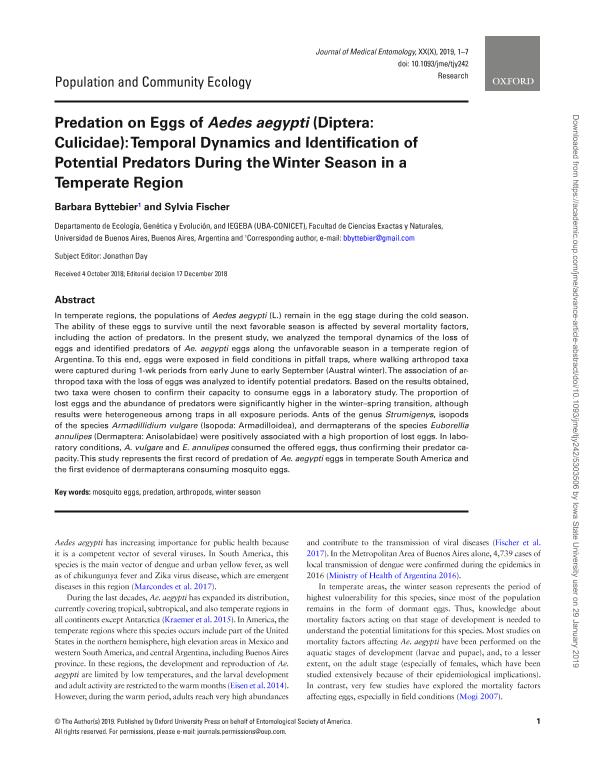Mostrar el registro sencillo del ítem
dc.contributor.author
Byttebier, Bárbara

dc.contributor.author
Fischer, Sylvia Cristina

dc.date.available
2022-02-14T20:05:07Z
dc.date.issued
2019-05
dc.identifier.citation
Byttebier, Bárbara; Fischer, Sylvia Cristina; Predation on Eggs of Aedes aegypti (Diptera: Culicidae): Temporal Dynamics and Identification of Potential Predators During the Winter Season in a Temperate Region; Entomological Society of America; Journal of Medical Entomology; 56; 3; 5-2019; 737-743
dc.identifier.issn
0022-2585
dc.identifier.uri
http://hdl.handle.net/11336/151965
dc.description.abstract
In temperate regions, the populations of Aedes aegypti (L.) remain in the egg stage during the cold season. The ability of these eggs to survive until the next favorable season is affected by several mortality factors, including the action of predators. In the present study, we analyzed the temporal dynamics of the loss of eggs and identified predators of Ae. aegypti eggs along the unfavorable season in a temperate region of Argentina. To this end, eggs were exposed in field conditions in pitfall traps, where walking arthropod taxa were captured during 1-wk periods from early June to early September (Austral winter).The association of arthropod taxa with the loss of eggs was analyzed to identify potential predators. Based on the results obtained, two taxa were chosen to confirm their capacity to consume eggs in a laboratory study. The proportion of lost eggs and the abundance of predators were significantly higher in the winter–spring transition, although results were heterogeneous among traps in all exposure periods. Ants of the genus Strumigenys, isopods of the species Armadillidium vulgare (Isopoda: Armadilloidea), and dermapterans of the species Euborellia annulipes (Dermaptera: Anisolabidae) were positively associated with a high proportion of lost eggs. In laboratory conditions, A. vulgare and E. annulipes consumed the offered eggs, thus confirming their predator capacity.This study represents the first record of predation of Ae. aegypti eggs in temperate South America and the first evidence of dermapterans consuming mosquito eggs.
dc.format
application/pdf
dc.language.iso
eng
dc.publisher
Entomological Society of America

dc.rights
info:eu-repo/semantics/openAccess
dc.rights.uri
https://creativecommons.org/licenses/by-nc-sa/2.5/ar/
dc.subject
ARTHROPODS
dc.subject
MOSQUITO EGGS
dc.subject
PREDATION
dc.subject
WINTER SEASON
dc.subject.classification
Ecología

dc.subject.classification
Ciencias Biológicas

dc.subject.classification
CIENCIAS NATURALES Y EXACTAS

dc.title
Predation on Eggs of Aedes aegypti (Diptera: Culicidae): Temporal Dynamics and Identification of Potential Predators During the Winter Season in a Temperate Region
dc.type
info:eu-repo/semantics/article
dc.type
info:ar-repo/semantics/artículo
dc.type
info:eu-repo/semantics/publishedVersion
dc.date.updated
2020-11-20T14:51:24Z
dc.journal.volume
56
dc.journal.number
3
dc.journal.pagination
737-743
dc.journal.pais
Estados Unidos

dc.journal.ciudad
Lanham
dc.description.fil
Fil: Byttebier, Bárbara. Consejo Nacional de Investigaciones Científicas y Técnicas. Oficina de Coordinación Administrativa Ciudad Universitaria. Instituto de Ecología, Genética y Evolución de Buenos Aires. Universidad de Buenos Aires. Facultad de Ciencias Exactas y Naturales. Instituto de Ecología, Genética y Evolución de Buenos Aires; Argentina
dc.description.fil
Fil: Fischer, Sylvia Cristina. Consejo Nacional de Investigaciones Científicas y Técnicas. Oficina de Coordinación Administrativa Ciudad Universitaria. Instituto de Ecología, Genética y Evolución de Buenos Aires. Universidad de Buenos Aires. Facultad de Ciencias Exactas y Naturales. Instituto de Ecología, Genética y Evolución de Buenos Aires; Argentina
dc.journal.title
Journal of Medical Entomology

dc.relation.alternativeid
info:eu-repo/semantics/altIdentifier/url/https://academic.oup.com/jme/article/56/3/737/5303506
dc.relation.alternativeid
info:eu-repo/semantics/altIdentifier/doi/http://dx.doi.org/10.1093/jme/tjy242
Archivos asociados
